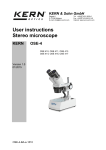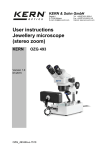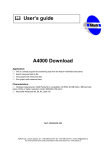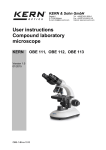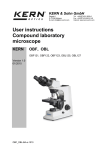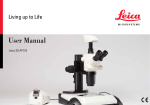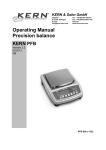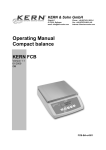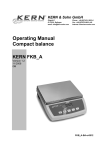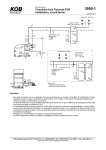Download User instructions Stereo microscope
Transcript
KERN & Sohn GmbH Ziegelei 1 D-72336 Balingen E-mail: [email protected] User instructions Stereo microscope KERN OSF-4G OSF 438, OSF 439 Version 1.0 01/2015 OSF-4G-BA-e-1510 Tel: +49-[0]7433- 9933-0 Fax: +49-[0]7433-9933-149 Internet: www.kern-sohn.com GB KERN OSF-4G Version 1.0 01/2015 User instructions Stereo microscope Table of contents 1 Before use .................................................................................... 3 1.1 1.2 1.3 1.4 General notes ............................................................................................................................ 3 Notes on the electrical system ................................................................................................ 3 Storage ...................................................................................................................................... 4 Maintenance and cleaning ....................................................................................................... 5 2 Nomenclature ............................................................................... 6 3 Basic data ..................................................................................... 7 4 Assembly ...................................................................................... 8 5 Operation and functionality....................................................... 10 5.1 5.2 5.3 5.4 5.5 5.6 5.7 5.8 5.9 Getting started ........................................................................................................................ 10 Adjusting the interpupillary distance ................................................................................... 10 Adjusting the magnification .................................................................................................. 10 Dioptre adjustment and focussing ....................................................................................... 11 Adjusting the stand ................................................................................................................ 11 Using eye cups / High Eye Point eyepieces ........................................................................ 12 Lighting control ...................................................................................................................... 13 Using external illumination units .......................................................................................... 13 Changing the bulb .................................................................................................................. 14 6 Optical data ................................................................................ 14 7 Features ...................................................................................... 14 8 Trouble shooting ........................................................................ 15 9 Service ........................................................................................ 16 10 Disposal ...................................................................................... 16 11 Further information .................................................................... 16 OSF-4G-BA-e-1510 2 1 Before use 1.1 General notes You must open the packaging carefully, to make sure that none of the accessories in the packaging fall on the floor and get broken. In general, microscopes should always be handled carefully because they are sensitive precision instruments. When using or transporting the microscope it is particularly important to avoid abrupt movements, as this may damage the optical components. You should also avoid getting dirt or finger prints on the lens surface, because in most cases this will reduce image clarity. To maintain the performance of the microscope, it must never be disassembled. So components such as lenses and other optical elements should be left as they were before use. Also the electrical parts in the base of the device must not be tampered with, as in this area there is an additional risk of triggering an electric shock. 1.2 Notes on the electrical system Before connecting to a mains power supply, you must make sure that you are using the correct input voltage. The mains cable supplied has an external power supply. The necessary values are shown on this power supply. If you do not comply with these specifications, then fires or other damage to the device could occur. The lighting switches must also be switched off before the mains cable is connected. In this way you will avoid triggering an electric shock. If you are using an extension cable, then the mains cable you use must be earthed. When carrying out any procedures whereby you come into contact with the electrical system of the device, such as, for example, changing the bulb, only carry out these procedures when the power is disconnected. 3 OSF-4G-BA-e-1510 1.3 Storage You should ensure that the device is not exposed to direct sunlight, temperatures which are too high or too low, vibrations, dust or a high level of humidity. The ideal temperature range is between 0 and 40°C and a relative humidity of 85% should not be exceeded. The device should always be located on a rigid, smooth, horizontal surface. For devices with pillar stands, the microscope holder must not be rotated back too far. If you do this, there is a risk that the microscope could tip over. When the microscope is not being used, you should fit the objective cap and cover the microscope with the enclosed dust protective cover. If the eyepieces are being stored separately, the protective caps must be fitted to the tube connectors. In most cases, if dust and dirt gets inside the optical unit of a microscope this can cause irreversible errors or damage. The best way to store accessories which consist of optical elements, such as, for example, eyepieces and objectives, is in a dry box with desiccant. OSF-4G-BA-e-1510 4 1.4 Maintenance and cleaning In any event, the device must be kept clean and dusted regularly. If any moisture should be occur, before you wipe down the device you must ensure that the mains power is switched off. When glass components become dirty, the best way to clean them is to wipe them gently with a lint-free cloth. To wipe oil stains or finger prints off the lens surface, moisten the lint free cloth with a mixture of ether and alcohol (70 / 30 ratio) and use this to clean the lens. You must be careful when handling ether and alcohol, as these are highly flammable substances. You must therefore keep it away from naked flames and electrical devices which can be switched on and off, and only use it in well-ventilated rooms. However organic solutions of this type should not be used to clean other components of the device. This could lead to damage to the paint finish. To do this, it is sufficient to use a neutral cleaning product. You could also use the following cleaning products to clean the optical components: Special cleaner for optical lenses Special optical cleaning cloths Bellows Brush When handled correctly and checked regularly, the microscope should give many years of efficient service. Should repairs still be necessary, please contact your KERN dealer or our Technical Department. 5 OSF-4G-BA-e-1510 2 Nomenclature OSF-4G-BA-e-1510 6 3 Basic data Optical system Greenough Dimmable lighting Yes Tube angled at 45° Interpupillary distance 55 – 75 mm Dioptre adjustment One-sided (left) Product dimensions WxDxH 230x180x275 mm Standard configuration Model Tube Eyepiece KERN Field of view Objective Stand Illumination mm OSF 438 Binocular WF 10x Ø 20 mm Ø 20 1x / 2x / 3x mechanical 1W LED (reflected light); 0,35W LED (transmitted light) OSF 439 Binocular WF 10x Ø 20 mm Ø 20 1x / 2x / 4x mechanical 1W LED (reflected light); 0,35W LED (transmitted light) 7 OSF-4G-BA-e-1510 4 Assembly The first step is to position the microscope stand on a firm, level surface. The holder is firmly attached to the pillar of the stand. The microscope head in turn is fixed to the holder, so that there is no possibility of spinning it. Please see section 5.5 for more details on adjusting the stand. Both eyepieces are already fitted in the tube. You just need to remove the protective film which covers them. When doing this make sure that you do not touch the optical lenses with your fingers. In general you should avoid using two eyepieces with different magnifications. When changing the eyepieces, you must also loosen the small silver screw under the eyepiece on the tube connectors and once the new eyepiece is fitted, then it must be re-tightened. With regard to the use of transmitted light illumination you must make sure that the frosted glass stand insert is fitted in the centre of the stand base, so that the transmitted light can be used correctly. Additional optional attachments: The eye cups supplied with the microscopes can be fitted to the eyepieces. (see section 5.6) OSF-4G-BA-e-1510 8 Assembled stereo microscope 9 OSF-4G-BA-e-1510 5 Operation and functionality 5.1 Getting started After assembly, if the microscope is ready for use, then you must first establish a power connection using the cable supplied. Please see section 5.7 for more details on adjusting the lighting. Do not forget to remove the cap from the bottom of the objective, so that you will then be able to see a reflection of the object being observed in the eyepiece. All important functions which relate to the use of the devices in this document are described in the following sections. 5.2 Adjusting the interpupillary distance Different users have different gaps between the eyes. So each time a different person uses the microscope, the gap between the two eyepieces must be readjusted. While you are looking through the eyepieces, use one hand to hold the righthand or lefthand prism housing firmly. By rotating outwards or inwards, you can either increase or reduce the gap between the eyes. As soon as the lefthand and righthand visual fields exactly overlap each other, this is the correct gap between the eyes. 5.3 Adjusting the magnification As the KERN OSF-4G series covers stereo microscopes (without zoom), we will describe how to set the magnification using the integrated and rotating objective. For the devices in this series, you can select between three different magnification factors at any time. Chapter 6 “Optical data” gives information on the possible overall magnification which the microscope can produce. It will also include the optional use of different eyepieces. OSF-4G-BA-e-1510 10 5.4 Dioptre adjustment and focussing A special feature of stereo microscopes is that they are fitted with an optical unit which has a relatively high depth of field. In order to be able get the most benefit from this feature, each user must synchronise the focussing mechanisms for themselves. The steps to do this are described in the following section. 1. Place the object to be observed on the surface under the objective. 2. Use the objective to set the smallest possible magnification. 3. Look through the righthand eyepiece (without dioptre adjustment ring) with the right eye and bring the object into focus by using the focus control dials. 4. Now set the largest magnification. 5. Once again, still only looking through the righthand eyepiece, bring the object into focus 6. Then set the smallest possible zoom factor again. 7. Then look through the lefthand eyepiece with the left eye (with dioptre adjustment ring) and bring the object into focus, by turning the dioptre adjustment ring left or right at the right point. 8. In order to get the highest level of accuracy when adjusting the focus, you should repeat steps 4-7. 9. In this way, the object being observed will be in focus on any magnification setting. 5.5 Adjusting the stand Torque of the focus wheels You adjust the torque of the focus wheels by holding one of the two wheels in place and using the other hand to turn the other wheel. Depending on the direction of the turn, the torque will be increased or decreased. On one hand, this function can help to make it easier to adjust the focus and on the other hand it can prevent the microscope head from slipping down unintentionally. In this way you can avoid possible damage which could occur if the objective lens and the object being observed should collide. 11 OSF-4G-BA-e-1510 5.6 Using eye cups / High Eye Point eyepieces The eye cups supplied with the microscope can basically be used at all times, as they screen out intrusive light, which is reflected from light sources from the environment onto the eyepiece, and the result is better image quality. But primarily, if eyepieces with a high eye point (particularly suitable for those who wear glasses) are used, then it may also be useful for users who don’t wear glasses, to fit the eye cups to the eyepieces. These special eyepieces are also called High Eye Point eyepieces. They can be identified by the glasses symbol on the side. They are also marked in the item description by an additional “H” (example: HSWF 10x Ø 23 mm). When fitting the eye cups, make sure that the dioptre setting is not moved. We would therefore advise that you hold the dioptre adjustment ring on an eyepiece with one hand while you fit the eye cup with the other. Before using the microscope, users who wear glasses must remove the eye cups, which you may find on High Eye Point eyepieces. As the eye cups are made of rubber, you must be aware that when you are using them, they can become slightly dirty through grease residues. In order to maintain hygiene, we would therefore recommend that you clean the eye cups regularly (e.g. with a damp cloth). Eye cups High Eye Point eyepiece (identified by the glasses symbol) OSF-4G-BA-e-1510 12 5.7 Lighting control The microscopes in the OSF-4G series have an adjustable reflected and transmitted light illumination. The power supply is guaranteed by connecting the mains cable and pressing the main switch on the right, rear corner. The control wheel on the righthand side surface of the stand base is responsible both for on-/off-switching and the adjustment of the light intensity of the transmitted illumination. The same functions belong to the control wheel on the lefthand side surface of the stand base according to the reflected illumination. 5.8 Using external illumination units If, when using a microscope in its standard version, the lighting is not suitable for the application, then it often makes sense to fit an external lighting unit to overcome this problem. The lighting units which are suitable for devices of the OSF-4G series, are goose neck lighting units (see figure). These are available as LED as well as halogen versions and also have an on/off switch or different controller. Typical goose neck lighting unit Using goose neck lighting units Depending on the requirements, a goose neck lighting unit is placed next to, in front of or behind the microscope. The light source is in the housing of the unit and is emitted through one or several optical fibre cables. These cables are flexible and therefore offer a large number of positioning options, so that the object being observed is perfectly illuminated. 13 OSF-4G-BA-e-1510 5.9 Changing the bulb LED The devices in the OSF-4G series are all fitted with LED bulbs. Due to the long service life of an LED lighting system, for these microscopes it will not be necessary to simply change a bulb. Problems with the lighting unit would therefore, in most cases, be caused by defects in the electrical system. If this is the case, then our Technical Service will be able to help. 6 Optical data 7 Features Model outfit Eyepieces Stand Stand inlay External illumination WF 5x / Ø 16.2 mm WF 10x / Ø 20 mm WF 15x / Ø 15 mm WF 20x / Ø 10 mm mechanical, incl. carrying handle with LED lighting (0.35W transmitted light + 1W reflected light) Frosted glass / Ø 59,5 mm black-white / Ø 59,5 mm Kern model OSF 438 OSF 439 ○○ ○○ ●● ●● ○○ ○○ ○○ ○○ ● ● ● ● ● ● Order number OZB-A4101 OZB-A4102 OZB-A4103 OZB-A4104 OZB-A4815 OZB-A4816 For information on external lighting units, please see the Kern Optics main catalogue, from page 68 and visit our website www.kern-sohn.com ● = Standard configuration OSF-4G-BA-e-1510 ○ = Option 14 8 Trouble shooting Electrical system Problem Possible causes The lighting unit (if fitted) cannot be The power cable is either not connected or switched on not connected correctly The bulb is not fitted The bulb has blown The fuse has blown The brightness control is set to the lowest level The bulb has blown The wrong bulb has been used The input voltage was too high The bulb flickers The bulb is not correctly fitted The lamp is worn out The bulb brightness is not sufficient The wrong bulb has been used The input voltage is too low Optical unit Problem Possible causes You can see two images The gap between the eyes is not set correctly The magnifications of the eyepieces do not match There is dirt on the object being observed There is dirt in the visual field There is dirt on the eyepiece surface The image is unclear There is dirt on the objective surface The focus wheels are jammed The torque of the focus wheels is set too high The microscope head slips down The torque of the focus wheels is set too low while you are viewing the object Eyes get tired easily The dioptre adjustment is not correct The brightness adjustment is not correct 15 OSF-4G-BA-e-1510 9 Service If, after studying the user manual, you still have questions about commissioning or using the microscope, or if unforeseen problems should arise, please get in touch with your dealer. The device may only be opened by trained service engineers who have been authorised by KERN. 10 Disposal The packaging is made of environmentally-friendly materials, which you can dispose of at your local recycling centre. Disposal of the storage box and device must be carried out by the operator in accordance with all national or regional laws in force in the location of use. 11 Further information The illustrations may differ slightly from the product. The descriptions and illustrations in this user manual are subject to change without notice. Further developments on the device may lead to these changes. All language versions contain a non-binding translation. The original German document is the binding version. OSF-4G-BA-e-1510 16

















